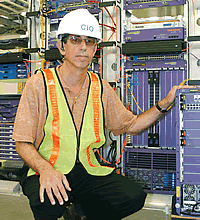
TECHNOLOGY AREA: CAMPUS INFRASTRUCTURE
Innovator: UC-Merced

KOGUT AT UC-MERCED: Go for
open-standards-based solutions, wherever possible.
Challenge Met
University of California-Merced, the first
new UC campus in nearly 40 years, opened
its doors to students in fall 2005. CIO Rich
Kogut and his IT staff worked on the site for
more than two years prior to welcoming the
initial student population of about 1,000.
Building a brand-new campus infrastructure
from the ground up presented an opportunity
to incorporate best practices across the
board. But the process was not without
challenges, given the magnitude of the project,
set in the resource-constrained environment
of a university system faced with
spiraling costs and persistent growth. How
would the institution’s IT leaders provide the services that faculty and students expect
immediately, while continuing to build out a
major research university destined to grow
to an enrollment of 25,000 over time?
Kogut and his colleagues responded with
a highly flexible, scalable, manageable, and
particularly user-centric infrastructure.
How They Did It
Planning for growth and change, these IT
leaders have adopted an architecture that
allows them to add, upgrade, and replace
functionality without a domino effect. Toward
that end, and to avoid vendor lock-in, they
implemented open standards-based infrastructure
and applications wherever possible.
For major technology components such
as networks, directories, and e-mail, they
only accepted RFP submissions based on
non-proprietary solutions and features.
UC-Merced uses a single ID/password and
a universal portal. The school went with an
open source portal solution, JA-SIG’s uPortal, to make it easier to implement
a vast array of applications over time.
Unicon provided key assistance
in configuring and deploying uPortal.
The campus employs many vendors and
technology solutions, including telecommunications
from AT&T; networking
from Extreme Networks; Cisco Systems’ wireless solution; servers and directory,
e-mail, and identity management solutions
from Sun Microsystems; Oracle’s calendaring
and database solutions; Sakai’s collaboration and learning environment;
and open source support from
rSmart.
Kogut and his central IT team are responsible
for UC-Merced’s entire IT infrastructure
and application portfolio, with the exception
of financial and personnel systems hosted by
a sister campus. The build-out is far from
complete, but Kogut is pleased that the portal
and identity management system supports
applicants, students, staff, and faculty,
and incorporates e-mail and Sakai as tabs.
The same ID and password are used for the
portal, calendaring, e-mail, VPN, wireless
authentication (802.1x), registration, bill payment,
vacation/time reporting, printing, file
services, document management, and other
applications, giving UC-Merced a terrifically
user-centric and sustainable IT infrastructure.
Next Steps
For UC-Merced, a vital ongoing task is to continue
to bring more applications and content
into the portal, and to expand the reach of
single sign-on. The school has joined InCommon, and will
participate in UC Trust, a Shibboleth-based federated identity and authentication
program supporting access across
the entire UC system.
Advice
Kogut recommends establishing a clear
vision and strategies early on. “Technology
changes frequently, and it is important to plan
with that in mind,” he says. “Well-understood
strategies allow greater delegation of investigation
and decision-making to a wider array
of staff, increasing productivity.”